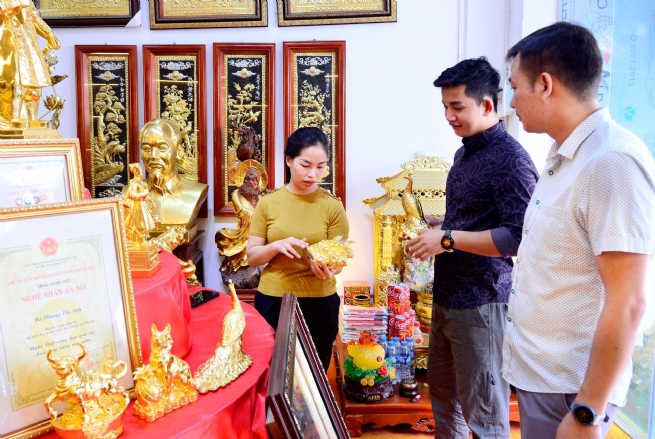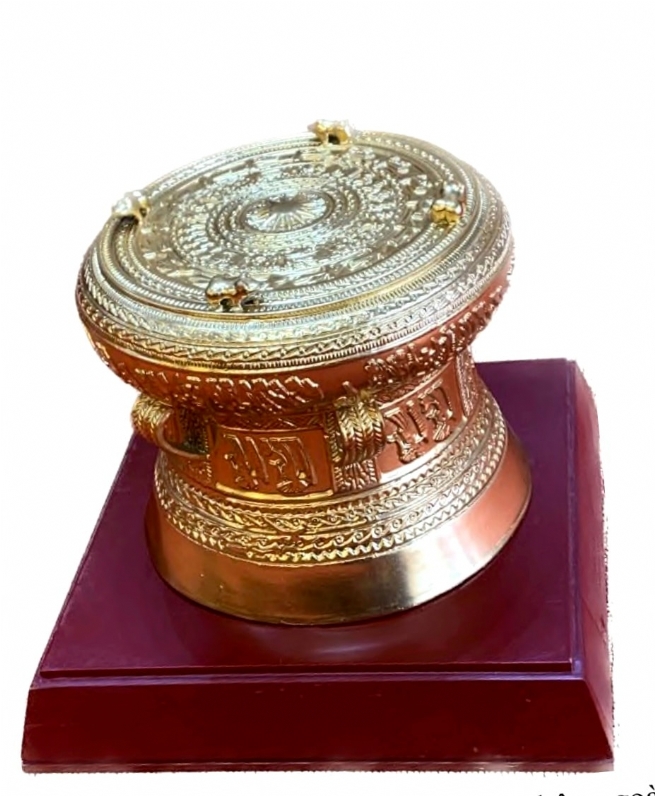9:39:10 AM | 10/17/2024
In 2023, Kieu Ky - an ancient village in the Red River Delta was honored to receive the National Intangible Cultural Heritage Certificate for its gold and silver leafing craft. According to historical records: The gold leafing and silver leafing craft appeared in Kieu Ky since the Later Le Dynasty and to this day, Kieu Ky is the only village in Vietnam specializing in gold, silver leafing, and leafing. Having gone through many ups and downs, to this day, the people of Kieu Ky still remember by heart two proud verses about their village: "The mighty enemy is famous in the North, The exquisite gold leafing is famous in the South"

It can be said that the gold leafing and silver leafing craft has crystallized the creativity of the people of Kieu Ky over many generations. Each gold-plated product demonstrates the knowledge, skills, sophistication, and unique mark of the craftsman because each product is made without using any machinery or equipment, completely by hand. Thanks to that, the Kieu Ky gold and silver-making profession still maintains its unique quality and position throughout the country, receiving high appreciation not only from domestic customers but also from customers from demanding markets such as Japan or Europe... Notably, from 2020 to 2023, Kieu Ky Gold-plated Industrial Cooperative registered 5 typical gold-plated products of artisan Hoang Thi Anh to participate in the One Commune One Product (OCOP) Program. Of which, the products of Hung Dao Dai Vuong Tran Quoc Tuan statue, lotus bowl, bronze drum, and gold-plated orchid pot achieved 4-star OCOP, and the gold-plated pipe product achieved 3-star OCOP.
Unique features
The goldsmiths of Kieu Ky village can pound a thin gold bar into 980 gold leaves, equivalent to an area of more than 1m2. The gold and silver leaves produced are used to decorate and gild royal architectural works, temples, pagodas, etc. throughout the country. For over 300 years, the ancient craft has been inherited and developed by the people of Kieu Ky, marking a unique feature of the Thang Long - Hanoi culture.
According to artisan Le Ba Chung, a Kieu Ky villager, to make a 490-leaf gold bar using the traditional method, a Kieu Ky craftsman must go through over 40 different stages. A skilled craftsman can pound a thin gold bar into 980 gold leaves with an area of more than 1m2. To do this, the craftsman must always pound steadily, without stopping, over 400 hammer blows, within an hour. If the gold leaf is allowed to rest for a while, it will gradually cool down and the process must be repeated. Currently, no industry can replace this method of manually pounding gold. Kieu Ky is the only craft village in the country that can do it.

According to long-time gold leaf craftsmen in Kieu Ky, to make thin gold and silver slices, the craftsmen must go through a meticulous manufacturing process. One of the steps is to make seed leaves to place on the rolled and cut pieces of gold and silver. Every 49 pieces of gold leaf are alternated between 50 seed leaves for use in the breaking process. This is the step that determines the quality of the gold and silver pounding process.
Long-time craftsmen in Kieu Ky added that the seed leaves interspersed with the gold leaves must be dry, tough, and elastic enough to not tear, or fade, and the glue must not mix with the gold, or so that the gold does not stick to the seed leaves when removed. When gliding and pounding the litmus paper, torn paper must be removed. If you forget to do so, the gold and silver will break or spread unevenly, affecting the quality of the litmus. Normally, the seed leaves can be used about 10 times depending on the experience of each household making gold litmus.
Long-time goldsmiths said that to shorten the production process, workers have gradually replaced some manual steps with machines, to reduce labor, increase labor productivity, and meet market demand. From over 40 production steps, villagers have now reduced the manual production steps to about 20 steps. Some steps have been replaced, such as the preparation of gold and silver materials, which used to take a day to filter and roll thinly, but now can be purchased with pre-cut gold materials. The hammer used for gold plating has been improved so that workers can pound faster and more effectively.

The remaining stages are manual processes that require a high level of technique and intuitive perception from the worker. One of the stages is “making ink”, which requires a closed and low furnace, using pine resin mixed with sawdust and small pellets burned under an iron pot to create soot, making “gliding” ink. With gold leaf, the worker must manually pound it, requiring high concentration without rest, pounding, and feeling so that the fragile gold leaf does not tear. Then, from the thin gold leaves, the people of Kieu Ky take them everywhere, using them as materials to make fine art products, decorative materials gilded with red paint for architectural works of kings and temples, pagodas, and palaces across the country.
Preserving and promoting product value
To preserve and develop the gold and silver gilding profession, in recent years, Kieu Ky people have collaborated with other traditional craft villages to carve statues, engrave horizontal lacquered boards, parallel sentences, and lacquering such as Ha Thai, Son Dong, Vu Lang; Mai Dong, Dong Quang (Bac Ninh); Cat Dang (Nam Dinh); Bao Ha (Hai Phong) ... to increase the value of craft village products, trade, and stabilize product output. Many artisans in Dinh Bang, Hue, and the South are Kieu Ky's trading partners. Recently, interior decoration artists of large architectural works have sought out Kieu Ky's gold gilding to coordinate in implementing large projects. These include: the Hanoi Opera House, Ho Chi Minh Museum, Trieu To Temple (Hue Imperial Citadel), Truc Lam Bach Ma Zen Monastery (Thua Thien Hue), Nam Thien Nhat Tru Pagoda (Ho Chi Minh City), and domestic projects and hotels. Cultural and architectural heritages recognized by UNESCO such as Hue Imperial City, Hoi An, and the Temple of Literature - Quoc Tu Giam are indispensable for gold and silver bullion.

Kieu Ky currently has about 50 families specializing in gold bullion trading, many households produce on a large scale, attracting about 300 - 400 workers, with an average income of 5-10 million/month. Many households have to borrow up to 20 more workers to produce, to meet market demand. Many families in Kieu Ky use about 10 taels of gold per month as raw materials for production, maintaining 10 workers regularly, producing gold bullion all year round. The busiest time for goldsmithing is at the end of the year, the items that need to be gilded in Kieu Ky are diverse, such as horizontal lacquered boards, parallel sentences, worship statues, decorative items such as souvenirs, lacquer paintings, ceramics, display products, interior decoration... Kieu Ky villagers receive many orders from many localities across the country, thereby increasing income, and helping to build a prosperous and happy life in their homeland sustainably.
Artisan Chung said that currently, the villagers are actively researching, creating and finding new directions to promote and develop the village. In addition to producing traditional products, the villagers are active in expanding the production of gold leaf on decorative products, gifts, especially interior and exterior works..., receiving the love of customers in many provinces and cities across the country.
In the current trend of developing craft village tourism, besides the craft, the traditional cultural values of Kieu Ky are opening up potential, exploiting to build tourist destinations, craft village tourism routes, spiritual tourism routes from Hanoi to Bat Trang, Chu Dong Tu temple, Kieu Ky, Ba Tam pagoda, Giong temple (Phu Dong) ... helping Kieu Ky gold and silver village become an attractive tourist destination, thereby introducing a beautiful image of the land and people of the Capital to domestic and international friends.
By Hien Ngoc, Vietnam Business Forum
The page is coordinated by the Hanoi Office of the Coordination of the New Rural Development Program